A helpful guide for teachers and parents. Definitions and examples of digraphs in words, lists of vowel digraphs, consonant digraphs and split digraphs, plus common questions about digraphs.
Contents
Digraphs Meaning
Most phonics programmes define digraphs as a combination of two letters that represent one sound (or phoneme) in a word.
For example, the UK Government’s phonics guidance booklet, Letters and Sounds1, gives the following definition of digraphs:
“A digraph is a two-letter grapheme where two letters represent one sound such as ‘ea’ in ‘seat’ and ‘sh’ in ‘ship’.”
Popular phonics programmes such as Jolly Phonics and Sound-Write use similar definitions2,3.
Some sources say that digraphs can represent more than one phoneme in a word. However, the ‘two letters, one sound definition is almost always used in phonics instruction.
Whatever definition is used, the sounds represented by digraphs are often different from the sounds normally represented by the individual letters that make up the digraph.
For example, the letters ‘s’ and ‘h’ represent different sounds in ‘snake’ and ‘hat’ from the sound represented by the ‘sh’ digraph in ‘ship’.
And the digraph ‘ch’ represents a completely different sound in words like ‘chop’ from the sounds represented by ‘c’ or ‘h’ in many other words.
There are some exceptions to this though. For instance, the ‘ck’ digraph found in words such as ‘clock’ or ‘brick’ represents the same sound as the individual letters ‘c’ and ‘k’. However, it’s still a digraph because the two letters only represent one sound.
Similarly, the double consonants in ‘huff’, ‘doll’ and ‘mess’ represent the same sounds as the individual consonants. However, the ‘ss’ digraph can represent a different sound in some words; for example, it represents the /sh/ sound mission and passion.
The short video below explains digraphs quite clearly:
And the video below from the Alphablocks guide to phonics explains the idea in a very child-friendly way:
Types of Digraph
Digraphs can be made up of:
- two consonants; for example, ‘ch’ in ‘chicken’ or ‘ph’ in ‘phone’,
- 2 vowels; for example, ‘ee’ in ‘feet’ or ‘ou’ in ‘sound’, or
- a consonant and a vowel; for example, ‘ar’ in ‘park’ or ‘ew’ in ‘blew‘,
- 2 vowels separated by a consonant (see split digraphs below).
What Are Split Digraphs?
Like regular digraphs, split digraphs have a pair of letters that represent one sound, but split digraphs have a consonant letter between the two digraph letters.
For example, in the word rope, the consonant letter p ‘splits’ the ‘oe’ digraph which represents the /oa/ sound.
Similarly, the letter t in the word kite separates the ‘i’ and ‘e’ in the ‘ie’ digraph.
Split digraphs always represent a long-vowel sound.
Words containing split digraphs are described as ‘magic e’ words or ‘silent e’ words in some reading programmes because the second letter in a split digraph is always an ‘e’.
How Many Split Digraphs Are There?
There are 6 split digraphs in written English:
- ‘a-e’, as in ‘ape’, ‘bake’, ‘came’ and ‘gale’,
- ‘e-e’, as in ‘Eve’ ‘Pete’, ‘swede’ and ‘theme’,
- ‘i-e’, as in ‘bike’, ‘dice’, ‘hide’ and ‘kite’,
- ‘o-e’, as in ‘bone’, ‘choke’, ‘doze’ and ‘home’,
- ‘u-e’, as in ‘cute’, ‘Duke’, ‘mule’ and ‘tube’,
- ‘y-e’, as in ‘byte’, ‘hype’, style and ‘type’.
It’s easy to forget the ‘y-e’ split digraph because we often think of the letter y as a consonant. However, ‘y’ represents a vowel sound in many words and ‘ye’ acts as a regular digraph in some common words such as dye and goodbye.
A few words have more than one letter in the middle of the split digraph, but this letter pattern is quite rare. Apart from the word clothes, which appears in a list of the top 300 most common words4, the only other examples we can think of that might appear in children’s literature are ‘ache’ and ‘scythe’.
When Are Split Digraphs Introduced?
Schools in England usually teach split digraphs sometime in year 1 (the academic year when children become 6 years old). This is in line with recommendations in the government’s ‘Letters and Sounds’ Phonics programme1 which includes split digraphs in phase 5 of the programme.
However, some aspects of phase 5 may begin in the latter part of reception with students who are making fast progress. Also, not all schools in England follow the Letters and Sounds programme so some schools might introduce split digraphs slightly earlier or later.
Children in schools in the US might meet split digraphs in first grade, but there is some variation in when particular digraphs are taught in different regions and even within schools in the same region.
Examples of Digraphs in Words
Digraphs are often listed separately as vowel digraphs and consonant digraphs.
What Are Vowel Digraphs?
Vowel digraphs can be defined as a pair of letters that represent a single vowel sound in a word.
Some sources say that vowel digraphs are made from two of the ‘vowel letters’ – a, e, i, o and u, but it isn’t that straightforward because digraphs containing other letters can also represent vowel sounds.
For example, the /ou/ sound in ‘cow’, the /oi/ sound in ‘toy’ and the /ar/ sound in ‘dark’ are all represented by digraphs that contain a consonant letter.
Opinions about what constitutes a vowel digraph can differ because the concept of vowels is more complicated than many people realise. And there are even different types of vowels such as diphthongs and murmur diphthongs.
Are Digraphs and Diphthongs the Same Thing?
Not exactly, digraphs are pairs of printed letters and diphthongs are the sounds represented by the letters. Some trigraphs are also used to represent the diphthong sounds.
Click on the following link to our article about diphthongs if you want more information about this.
Examples of Vowel Digraphs
The table below gives examples of vowel digraphs in alphabetical order, along with examples of words containing the digraphs. You will notice that many digraphs can represent different sounds in different groups of words.
The letters between forward slashes / / are used in the UK Government’s Letters and Sounds phonics programme1. The green symbols in round brackets are used in the International Phonetic Alphabet.
Click on the following link to view or download this vowel digraph list as a pdf.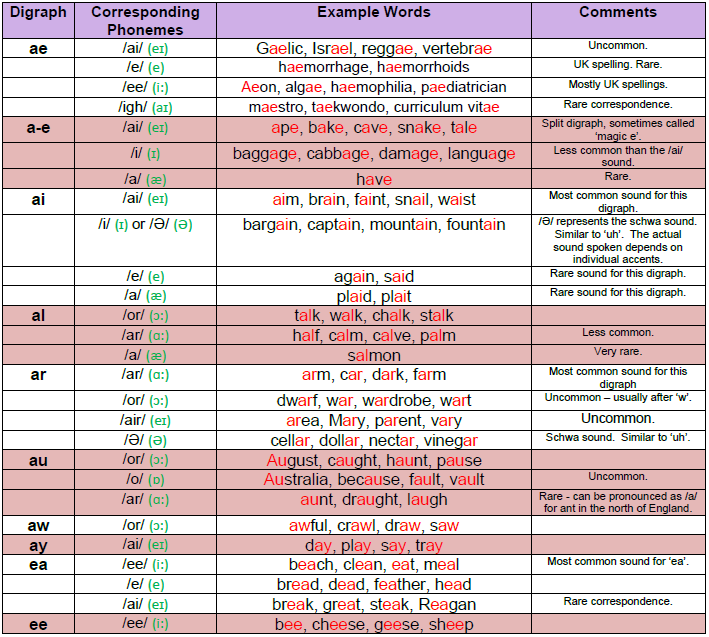
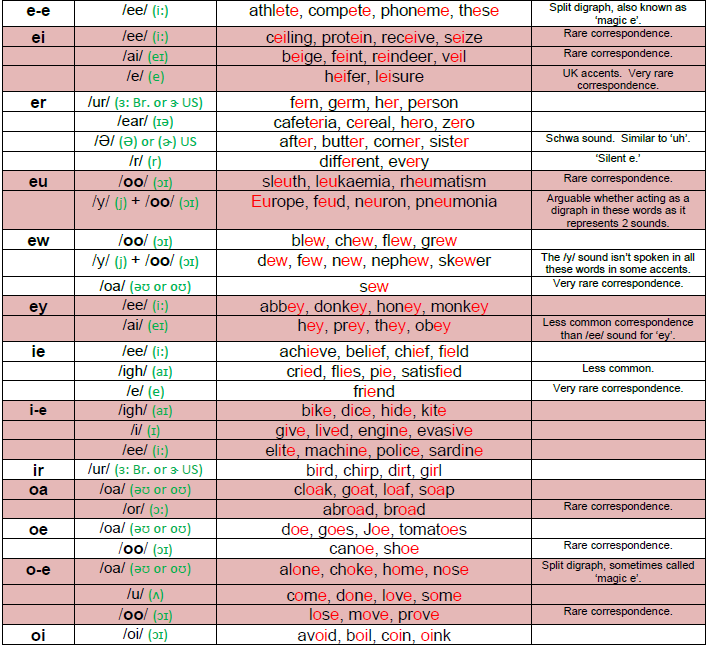
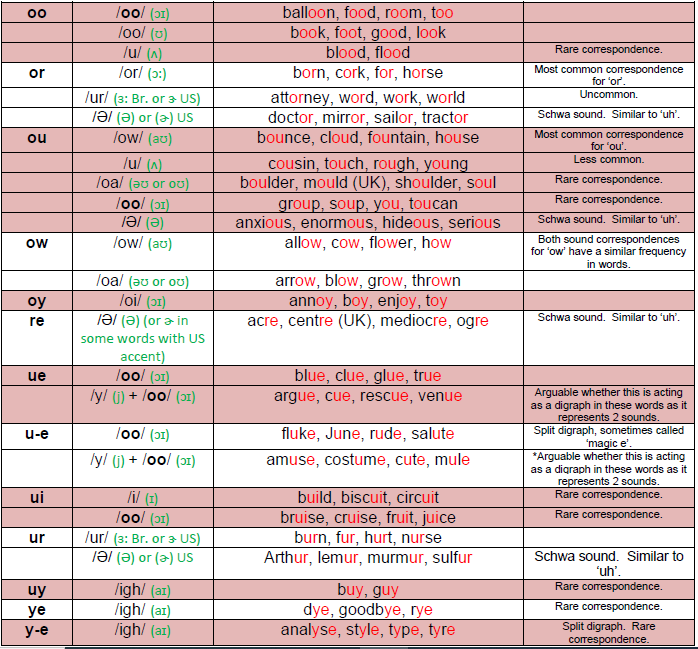
Examples of Consonant Digraphs
The table below gives examples of consonant digraphs in alphabetical order, along with examples of words containing the digraphs.
The letters between forward slashes / / are used in the UK Government’s Letters and Sounds phonics programme. The green symbols in round brackets are used in the International Phonetic Alphabet.
Click on the following link to view or download this consonant digraph list as a pdf.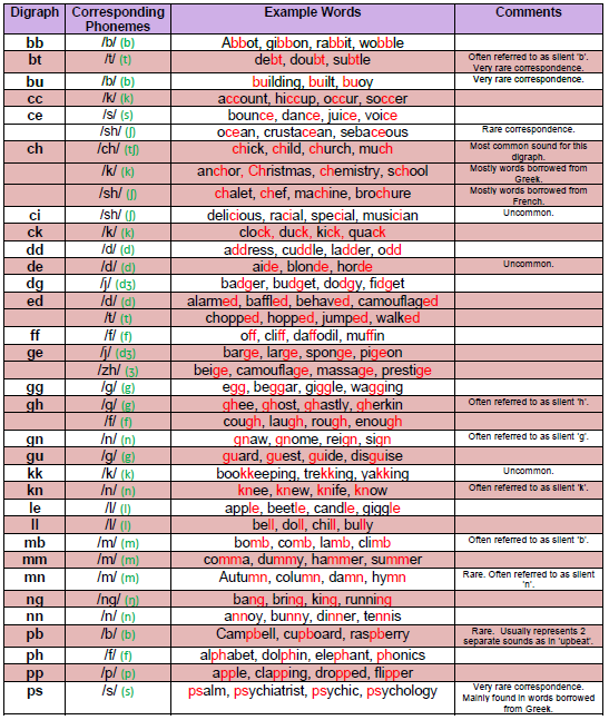
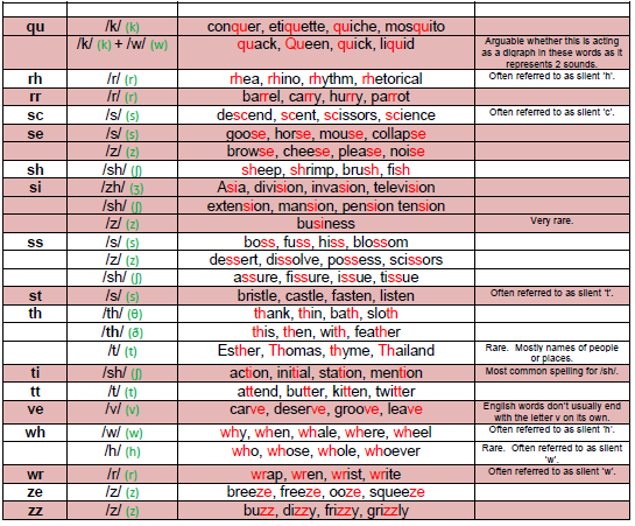
Miscellaneous Questions About Digraphs
How Many Digraphs are there in English?
We would estimate that there are over 125 digraphs in written English. There are approximately 50 vowel digraphs and 75 consonant digraphs.
We’ve listed 36 examples in our vowel digraphs table and there are about another 15 or so that only appear in a few words such as ‘aa’ in ‘baa’, ‘oh’ in ‘John’ and ‘wo’ in two. There might be a handful more that are rarely used in English words.
We’ve included 49 examples in our consonant digraphs table, but the number is closer to 75 if you include examples that only appear in a handful of words such as ‘di’ in ‘soldier’ (which represents a /j/ sound) or ‘gm’ in ‘diaphragm‘.
Alison Clarke from Spelfabet has compiled most of the spelling patterns that exists in written English. Follow this link to her ‘sorted by spelling’ page if you want to find a few more rare examples of digraphs and trigraphs.
Are Digraphs Phonemes?
No, phonemes are small units of sound that make up spoken words. Digraphs are letter pairs that represent phonemes in written words.
What is the Difference Between a Blend and a Digraph?
Each of the letters in a blend represents a separate sound, so blends that are made up of 2 letters represent 2 sounds, and 3-letter blends represent 3 sounds. In contrast, the letters in a digraph (or trigraph) only represent one sound.
For example, the highlighted letters in the word ‘clap’ are blends because they represent 2 separate sounds. The letter ‘c’ represents the same sound as it does in the word ‘cat’ and the letter ‘l’ represents the same sound as it does in the word ‘log’.
In comparison, the highlighted letters in the word ‘chop’ are an example of a digraph because they pair up to represent just one sound. In this word, the sound represented by ‘ch’ is quite different from the sounds commonly represented by the letters c and h in words such as ‘cat, or ‘hat’.
More examples…
Is ‘ng’ a Digraph or Blend?
Ng is normally described as a digraph because it represents a single sound in many words. For example, ‘King’, ‘sing’, ‘bang’ and ‘long’. When you say these words, you don’t hear the separate sounds normally associated with the letters n or g.
However, in multi-syllable words, when ‘ng’ is present in a boundary between 2 syllables, it often doesn’t act as a digraph.
For example, if you say the words ‘angry’, ‘conga’, ‘danger’, ‘fungi’ and ‘jingle’, the letters n and g represent separate sounds. So, in these examples, the letters are acting as blends.
Is ‘bl’ a Blend or Digraph?
We can’t think of any words where these two letters pair up to represent a single sound, so it’s an example of a blend and not a digraph. For example, in the words ‘black’, ‘blue’, ‘blink’ and ‘blow’, the letters b and l represent 2 separate sounds.
Can Digraphs be in the Middle of a Word?
Yes, this is especially true for vowel digraphs such as the ones highlighted in the words below:
Tail beef foot soap dark fork fern cloud coin
Some consonant digraphs can also be found in the middle of words. For example, the highlighted letters in dolphin and fishing.
Can Digraphs be at the End of a Word?
Yes, this is quite common for both vowel and consonant digraphs.
Example words with consonant digraphs at the end include fish, beach, clock, ring and path.
Examples with vowel digraphs at the end include play, flower, doctor, pea, donkey, draw, fur and boy.
Teaching Digraphs
Click on the following link for our guide to teaching digraphs at home or in school.
In the article, we discuss when and how digraphs are best taught, suggest teaching strategies and provide free digraph worksheets.
References:
- Letters and Sounds: Principles and Practice of High Quality Phonics: Notes of Guidance for Practitioners and Teachers, Primary National Strategy. Department for Education and Skills, 2007.
- Lloyd, S. (2008) Jolly Phonics, The Phonics Handbook, Jolly Learning Ltd.
- Walker, J. (2018) Help your child to read and write Part 2, Glossary of terms, free online course, Udemy.
- Masterson, J., Stuart, M., Dixon, M. & Lovejoy, S. (2003) Children’s Printed Word Database.